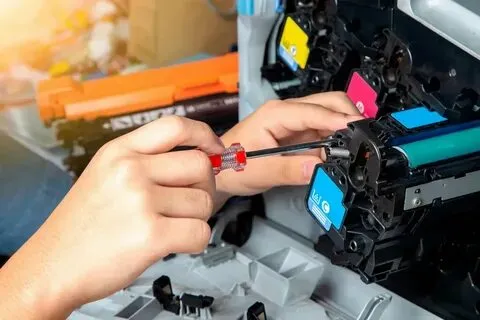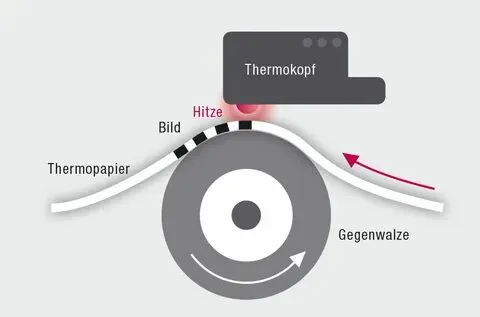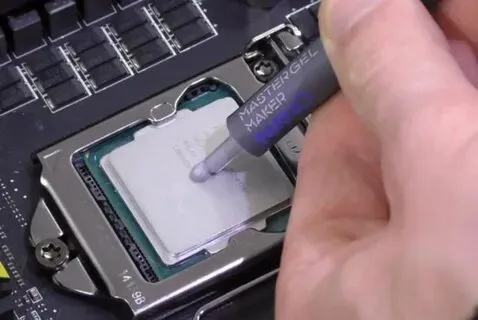Thermal printing usually lasts between 6 months to 7 years, depending on paper quality and storage. Learn how to protect your thermal prints from fading, damage, and heat exposure. Keep important labels and receipts readable for longer.
This guide explains what affects its lifespan, how to store it properly, and when it’s best to use thermal printing. Whether you’re in retail, logistics, or just saving receipts, understanding thermal print durability helps prevent the loss of important information and saves you from future hassle.
How to Extend the Life of Your Thermal Printer
To extend your thermal printer’s life, clean the print head regularly, use high-quality paper, avoid overheating by giving breaks, keep it dust-free, and update its firmware. Proper care prevents damage and ensures clear printing for a longer time.
Average Lifespan of a Thermal Printer

A thermal printer typically lasts 5 to 10 years, depending on usage, maintenance, and environment. Regular cleaning, quality supplies, and proper handling help extend its life and maintain print quality over time.
Factors Affecting the Lifespan of a Thermal Printer
Thermal printer lifespan depends on usage frequency, print volume, maintenance, printhead care, and environment. Lack of cleaning, dust, heat, and poor-quality paper can reduce the machine’s performance and shorten its life significantly.
Sign up to our newsletter!
Stay updated with the latest tips, guides, and expert advice. Get exclusive content, industry insights, and practical solutions delivered straight to your inbox—no spam, just real value every week. Sign up now, it’s free!
Get in Contact
Looking for expert advice, assistance, or a question? We’re here to help. Send us a message through our contact form, email, or phone—quick replies, clear answers, no hassle. Please let me know how I can help you.
When to Replace Your Thermal Printer

Replace your thermal printer when print quality worsens despite cleaning, paper jams increase, the device overheats frequently, or repair costs exceed buying new. Timely replacement saves time, ensures smooth printing, and avoids disrupting your daily work.
Cost-Benefit Analysis of Replacing a Thermal Printer
Replacing a thermal printer is worth it when repair costs rise and downtime affects work. New printers are faster, more reliable and of better print quality, will save you money in the long run. Compare upfront cost with benefits like less errors and less maintenance to decide wisely.
Also read must: How To Start A Print Shop- Start Printing Now!
Choosing a Durable Thermal Printer
Choose a durable thermal printer by checking its build, print speed and reliability. Look for models with long warranties, easy maintenance, and good reviews. A durable printer saves you money and hassle by lasting longer and working smoothly every day.
Factors That Affect Thermal Print Longevity
Thermal print longevity is dependent on paper quality, printer maintenance, heat exposure and storage conditions. Using good thermal paper, cleaning the print head, not too much heat and keeping prints out of sunlight will keep prints clear and last longer.
Type of Thermal Paper
Use high-quality, compatible thermal paper to ensure clear, long-lasting prints without fading or smudging.
Exposure to Heat or Light
Avoid direct sunlight and heat as they cause thermal prints to fade quickly.
Humidity and Moisture
Keep prints dry; moisture and high humidity blur or damage thermal paper.
Paper Quality and Brand
Choose trusted brands with stable coatings for better durability and consistent print quality.
Friction and Handling
Handle prints gently to prevent scratches and smudges that reduce readability.
Storage Environment
Store prints in cool, dark, and dry places to preserve print clarity over time.
How to Make Thermal Prints Last Longer

To make thermal prints last longer, use quality thermal paper, avoid exposure to heat and sunlight, store prints in dry, cool places, and handle them carefully to prevent scratches and fading. Regular maintenance of the printer also helps maintain print quality.
How to Tell If a Thermal Print Is Fading
You can tell a thermal print is fading if text or images become lighter, blurry or patchy over time. Fading gets worse with heat, light and moisture. Check prints regularly before important details disappear.
How Thermal Print Lifespan Impacts Business Operations
Thermal print lifespan affects business by influencing record clarity, customer trust, and compliance. Short-lived prints cause frequent reprints, delays, and extra costs. Longer-lasting prints improve efficiency, reduce errors, and support smooth daily operations, saving time and money.
Also read must: How To Remove Screen Printing from Polyester-Strip Print Safely!
How to Train Staff on Proper Print Handling
Train staff to handle prints gently, avoid heat and moisture, and store properly. Show them how to clean printers and use good quality paper. Clear instructions reduce damage, extend print life and make daily work smoother.
Labeling and storage best practices
Store prints in cool, dry places, label clearly, and avoid sunlight to keep prints sharp and durable.
Tips for extending print lifespan at work
Use quality paper, handle prints gently, and maintain printers regularly for longer-lasting results.
Mistakes employees make and how to avoid them
Avoid touching prints with dirty hands, exposing them to heat, or improper storage to prevent fading and damage.
Common Thermal Printing Problems and Solutions
Faded prints, paper jams, and uneven images are common thermal printing problems. Fix them by using quality paper, cleaning the printer head, and avoiding moisture or heat exposure. Regular maintenance reduces downtime and keeps printing smooth and reliable.
Fading too fast?
Use high-quality thermal paper and store prints away from heat, light, and moisture to slow down fading and keep text readable longer.
Uneven print or blank areas?
Clean the print head gently and check for dust or paper debris. Damaged or low-quality paper can also cause uneven or missing print lines.
Printer settings or paper issue?
Wrong settings or incompatible paper lead to poor print results. Match the paper type in printer settings and always use recommended thermal paper rolls.
Future of Thermal Printing: What to Expect

Thermal printing is moving towards eco-friendly paper, longer-lasting prints and smart printers with faster and more accurate printing. Expect lower costs, less waste and better performance.
Faqs
How long does a thermal printed document last?
A thermal printed document typically lasts 5 to 7 years if stored properly.
Will thermal print fade?
Thermal prints fade over time, especially with heat, light, and poor storage.
How can I extend the life of my thermal printer?
Use high-quality paper and store your thermal printer in a cool, dust-free place to extend its life.
Why are thermal printers so expensive?
A thermal printer costs more because it uses advanced printheads, requires durable parts, and prints without ink or toner.
What is the problem with thermal paper?
Thermal paper fades over time and is sensitive to heat, light, and moisture, making long-term storage unreliable.
conclusion
Thermal printing is fast and useful, but to keep prints clear and long-lasting, you must use good paper, store it properly, and train staff well. Watch for fading and fix issues early. With care, your prints stay sharp, and your business runs smoothly. Always follow simple tips to save time, avoid waste, and get the best results.
Also read must: How Much Is Metal 3d Printer-Find Best Deal!
